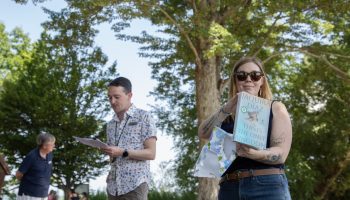
In 10 years of research into female biology’s impact on human history and culture, author and researcher Cat Bohannon determined that when trying to help the human population, solutions might lie in researching half of the whole.
“There are so many things that seem so intractable,” Bohannon said. “One of the few things that is fixable is the pipeline for women’s health — and that’s an achievable goal that will improve the human condition.”
Bohannon will discuss her breakthrough revision of human history placing the female body at the center, Eve: How the Female Body Drove 200 Million Years of Human Evolution, at 3:30 p.m. today in the Hall of Philosophy for the Chautauqua Literary and Scientific Circle.
In the CLSC selection for a week themed “Innovation in Capitalism: How to Meet 21st-Century Challenges?,” Bohannon navigates readjusting history to better understand the future of scientific studies and the well-being of the human race.
“The story of innovation has been a story about dudes. This book does the work of innovation by addressing history as female-driven,” Bohannon said.
Before embarking on her Doctor of Philosophy in evolution of narrative and cognition — and her book-writing journey — Bohannon received a Master of Fine Arts in creative nonfiction from Columbia University. Like many CLSC readers, Bohannon recognized the marriage between science and the arts from a young age.
“My dad is a scientist, and my mom is a pianist. In the making of the freak-ball of me, there was no moment where I thought these were separate ideas,” Bohannon said.
While helping her dad with slides in his psychology studies as a young girl, Bohannon saw female subjects and female scientists across the discipline. It was not until she entered Columbia University as a fresh graduate student — sitting with fellow Ph.D. candidates and passing around a bottle of whiskey — that she realized that the same reality was not true in all scientific disciplines.
When asking a neurology candidate why the principal investigator of a study did not care to investigate sex differences, Bohannon said he shared that the neurology department only studied male specimens.
“It was bewildering. I thought I was too drunk to understand him,” Bohannon said. “I had done scientific experiments, but I wasn’t an animal-model person. I did computational modeling and assumed, ‘Yeah, everything is chill in biology.’ ”
Everything was, in fact, not chill in biology. The reality was the “male norm,” or ongoing tendency to default to male bodies as standard in research, development and practice across scientific disciplines. In practice, researchers all but ignored the female body.
“Nobody in the public knew this,” Bohannon said, “The scientists who worked with female bodies assumed that everyone knew, and the ones who did not work with the female bodies knew and did not care.”
Bohannon recognized the absurdity and danger of this practice and dove into writing Eve as soon as she received a book deal in 2012, in addition to completing her doctorate. While writing Eve, Bohannon said the publication of Caroline Criado-Perez’s Invisible Women: Data Bias in a World Designed for Men granted her some peace of mind.
“Thank God someone said something,” she said. “It meant that I got to write Eve without having to bang the drum about the male norm on every page.”
Bohannon said she even thanked Perez for highlighting the gender gap when she met her. The book allowed Bohannon to delve into the history of evolution driven by the female body. After 10 years, three kids and a Ph.D. under her belt, Bohannon produced Eve, combining wit and humor with a deep dive into psychology, anthropology and human development.
Presenting the importance of investigating female bodies, Bohannon emphasized the power of studying female bodies as a means to improving general health: women make the majority of healthcare decisions for their families, from picking up medicine to deciding whether or not to take children, spouses or aging parents to the hospital.
“One hospital administrator told me women are the chief medical officers of their households. … So, the easiest way to make a nation sicker is to screw over their women,” Bohannon said. “Women are the deciders when it comes to medicine, yet they are the most neglected body.”
Thus, the benefit of studying female bodies extends to everyone.
“Guys die sooner. It would be nice to know why, to keep them alive, and to know why females are less likely to die. That would float all boats,” Bohannon said.
She’s excited about the work being done researching female bodies expanding beyond the limitations of studying pregnancy and female suffering alone. One of the many exciting developments Bohannon discusses in Eve is the ability of breastfeeding bodies to adjust their formula based on the saliva of their child. A mother of three, Bohannon was simultaneously delighted and disgusted by the discovery.
“Yes, it felt invasive and horrifying. But it was also comforting that somehow my boob was making milk for a sick kid — the fact that I could give them chicken noodle boob — I liked that,” Bohannon said.
While uncovering the magical properties of breastmilk, Bohannon also encountered horrifying insights as she dug into a history of scientific studies crafted around presenting women and people of color as inferior. Decades of these studies fueled a biased and discriminatory foundation for modern science — one that scientists still grapple with today.
“Rejecting that history is notoriously hard for cognitive researchers,” she said.
When writing her chapter on the brain, Bohannon was frustrated by the years of research focused on differentiating the female brain from the male.
“I was disappointed to find out that people still take IQ science at face-value,” Bohannon said, shocked that they don’t question it.
Eve balances Bohannon’s rigorous research with entertaining narratives, such as her recognition of “the male norm” in a frustrating scene in Ridley Scott’s “Alien” prequel, and learning about the price of the female body in a job interview for a call-in center at an escort agency.
Rather than craft every sentence in the service of a teaching moment, Bohannon said she aimed to share feelings of surprise, interest and tragedy with the reader. After all, each reader is the expert on their own body.
“There is nothing worse than someone patronizingly telling you about the body you live in,” Bohannon said. “It is better to share a laugh about bodies — bodies that are astonishingly alive — because it’s honestly amazing that any of this works. It shouldn’t, but it does.”




